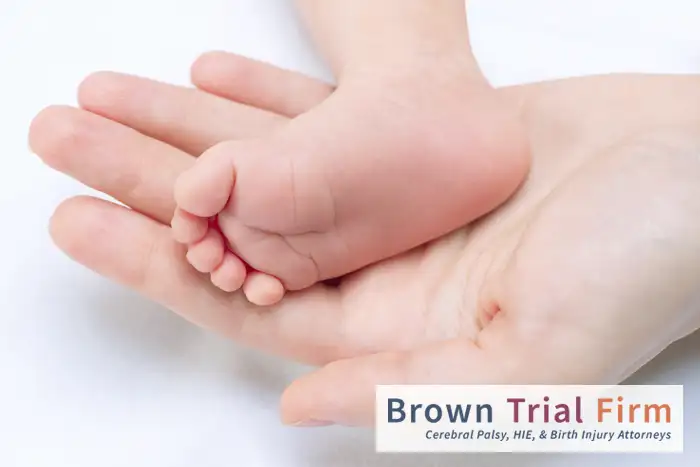Hospitals like Banner – University Medical Center and HonorHealth Sonoran Crossing Medical Center have helped thousands of parents in Phoenix welcome their precious babies into the world. Most of the time, deliveries go as planned, but sometimes mistakes are made that lead to birth injuries.
Unfortunately, when a birth injury occurs, it can be a devastating event that leaves families grappling with emotional, physical and financial challenges. In such times, seeking advice from a birth injury attorney can provide families with the guidance and support they need to navigate the complex legal process and get the compensation their child deserves.
If your baby suffered a birth injury as a result of a doctor’s or other health care provider’s negligence, experienced Phoenix birth injury attorney Laura Brown is ready to answer your questions and advocate on your behalf to get your family the financial help they need to secure a bright future for your child.
Statistics about births in Arizona
The last thing any parent wants to learn is that their baby suffered a birth injury or, even worse, died during or soon after childbirth. Sadly, this situation is more common in Phoenix than many people realize.
According to data from the Centers for Disease Control and Prevention (CDC), the infant mortality rate in Arizona in 2020 was 5.19 infant deaths per 1,000 live births, or 399 fatalities.
Unfortunately, many birth injuries and fatalities are preventable and caused by the negligence of medical professionals.
In 2020, Arizona saw nearly 77,000 live births and a fertility rate of 54 per 1,000 women, ranging from age 15 through 44. During the period from 2018 to 2020:
- 42.5% of the live births were Hispanic
- 41% were white
- 6% were Black
- 5% were Native American or Alaskan Native
- 4% were Asian or Pacific Islander
What’s the difference between a birth injury and a birth defect?
While both birth injuries and birth defects can result in serious medical issues and complications for babies, they have some notable differences.
A birth injury refers to harm or trauma that happens to a baby during labor and delivery, resulting from medical negligence, errors or other complications. These injuries are often preventable.
By contrast, birth defects are usually present before birth and can be caused by genetic factors, such as exposure to toxins during pregnancy, or socioeconomic and demographic factors, like exposure to infection, use of alcohol or drugs, and a lack of access to prenatal care. Birth defects can affect various organs or body systems and may include conditions like heart defects, cleft palates or spina bifida.
Sometimes, there is no known cause of a birth defect, or a baby can have one due to a combination of factors. Regardless, unlike birth injuries, birth defects are not the result of medical negligence.
Birth injuries vs. birth defects: What’s the difference?
Learn the differences between birth injuries and defects, including common causes and treatment options.
What’s the most common birth trauma?
Birth injuries or trauma can affect babies during labor or delivery and vary in severity. The most common types include the following:
- Neonatal intracranial hemorrhage (brain bleed). A brain bleed can occur in a newborn for a variety of reasons, some of which may be due to medical negligence, such as an excessive use of force with forceps or a vacuum extractor during delivery. The effects of a brain bleed can range from minor symptoms that heal quickly to ones that can impact a child for a lifetime.
- Hypoxic-ischemic encephalopathy (HIE). Also called perinatal asphyxia, this condition results from insufficient oxygen levels during labor and delivery. The consequences of HIE can be significant and may result in long-term complications, such as developmental delays, cognitive impairments, motor disabilities and cerebral palsy.
- Cerebral palsy (CP). This condition causes problems with the muscles and develops as a result of a brain injury. Some babies develop cerebral palsy when they suffer from oxygen deprivation during birth.
- Cephalohematoma. This injury appears as a raised bump on the baby’s head. It’s characterized by bleeding under the cranial bone and is usually caused by a forceps delivery.
- Spinal cord injuries. Fetal positions during delivery and the use of assistive devices can lead to serious spinal cord injuries in infants. In some cases, a baby can be left with neurological damage or even paralysis.
- Erb’s palsy. Also referred to as brachial plexus palsy, this birth injury results from an injury to the nerves in the brachial plexus area, which is located in the upper spine and travels to the neck, shoulder, arm and hand. Sometimes, trauma can lead to a temporary or permanent disability.
- Epilepsy and seizures. A lack of oxygen or head trauma can lead to epilepsy and seizures, which are characterized by a sudden and temporary disturbance in the normal electrical activity of the brain. They often cause brief changes in behavior, movements, feelings, or consciousness. Babies who develop seizures are also at risk for HIE and cerebral palsy, so they need to be monitored closely after birth.
- Fractures. A baby can suffer a fracture from trauma during a difficult delivery, with the most common being a clavicle (collar bone) fracture. In some cases, these injuries heal on their own, but sometimes, the infant must be immobilized for the injury to heal.
- Facial paralysis. Facial paralysis occurs when the facial nerves become inflamed or damaged. In some cases, it’s genetic, but it can also result from birth trauma, such as a doctor’s use of assistive devices like forceps or vacuum extraction during childbirth.
How does cerebral palsy happen during birth?
Cerebral palsy is a neurological disorder that affects muscle control, coordination and movement. While the exact cause of cerebral palsy is not always clear, it can occur during birth due to certain factors, including:
- Oxygen deprivation. If a baby’s brain does not receive enough oxygen during labor and delivery, it can lead to brain damage and increase the risk of cerebral palsy. This can happen due to complications such as a prolonged or difficult delivery, umbilical cord problems, placental issues or maternal health conditions.
- Traumatic birth injury. Physical trauma during delivery, such as the improper use of forceps or vacuum extraction, can cause damage to a baby’s brain, leading to cerebral palsy.
- Premature birth. Babies born prematurely, especially those born before 32 weeks of gestation, have a higher likelihood of developing cerebral palsy compared to full-term babies. This is because the underdeveloped brain can be more susceptible to factors such as oxygen deprivation, brain bleeds (intraventricular hemorrhage) and infection, which can result in brain damage and subsequent cerebral palsy.
- Infections or maternal health conditions. Certain infections contracted by the mother during pregnancy, such as rubella or cytomegalovirus, or maternal health conditions like high blood pressure or diabetes, can increase the risk of cerebral palsy in a baby.
My baby has brain damage from birth. How do I know if it was caused by medical negligence?
If your child developed cerebral palsy, you’ll need help from an experienced Phoenix birth injury attorney, who can look through your medical records and determine if negligence may have played a role.
If your attorney believes there’s sufficient evidence of medical malpractice, they may be able to file a claim to get compensation for the medical care and treatment your child needs to live their life to the fullest.
It’s important to note that not all cases of cerebral palsy are caused by birth-related factors. Some cases may occur due to genetic or developmental abnormalities, prenatal brain abnormalities or events that happen after birth.
Unfortunately, there’s no cure for cerebral palsy, but it also won’t get progressively worse. Additionally, there are many treatment options available, and early intervention has been shown to greatly increase function and quality of life in children with CP.
What is the most misunderstood thing about cerebral palsy?
Learn about the top 10 myths related to cerebral palsy and the truth behind this condition.
What are the most commonly fractured bones during delivery?
Bone fractures are a fairly common occurrence during delivery, especially if a baby is large, which often happens when they’re past their due date. Fractures can also happen when a doctor relies on forceps or vacuum extraction to help with the birth.
The following are the most commonly fractured bones during childbirth:
- Clavicle fractures. Also called collarbone fractures, these are the most commonly suffered fractures during birth. A baby can typically heal within a few weeks by having their arm restrained to the chest.
- Growth plate fractures. Growth plates are areas of cartilage located at the ends of long bones, and they play a crucial role in bone growth. An injury to this area during birth is usually characterized by swelling in the affected arm or leg.
- Femur fractures. Sometimes, the infant suffers a femur fracture during delivery if their leg is twisted or in an awkward position.
Most fractures sustained during delivery resolve quickly, and babies usually don’t have any long-term effects after they heal.
Signs of developmental delays in babies & signs of a birth injury
Learn to identify the early signs of a birth injury to ensure the health and safety of your baby.
What is the number one complication of childbirth?
Perhaps the biggest complication of childbirth is a failure to progress, which occurs when the labor process is significantly delayed or stalls, resulting in prolonged labor. This condition can increase the risk of birth injuries for both the mother and the baby.
When labor fails to progress, it can cause several complications that can ultimately lead to birth injuries:
Prolonged labor can place excessive stress on the baby, resulting in fetal distress. The pressure on the baby’s body during an extended labor can increase the risk of oxygen deprivation, leading to potential brain damage and conditions such as cerebral palsy.
In rare cases, prolonged labor from strong and continuous contractions can lead to the rupture of the uterus. This can cause significant complications for both the mother and the baby, including severe bleeding, fetal distress and the need for an emergency cesarean section (C-section).
Instrument-assisted deliveries
To expedite the delivery process, healthcare providers may resort to instrument-assisted deliveries, such as vacuum extraction or forceps. These interventions carry a higher risk of birth injuries, including bruising, fractures or nerve damage to the baby’s head or face.
Healthcare providers should carefully monitor and manage cases of prolonged labor to minimize the risk of birth injuries. This may involve close monitoring of the baby’s heart rate, assessing maternal health and well-being and considering appropriate interventions, such as assisted deliveries or C-sections, when necessary.
If you believe that a failure to progress during labor has resulted in a birth injury to your child, it’s essential to consult a birth injury attorney who can evaluate the circumstances surrounding your labor and delivery to determine if medical negligence or malpractice may be the cause.
How do you prove a birth injury was caused by medical negligence?
Not every birth injury necessarily qualifies for compensation. To obtain compensation in Phoenix, you’ll need to be able to prove that the injury was the result of negligence. To do this, your attorney will need to establish the following elements:
- Duty of care. It must be shown that a healthcare provider had a duty to provide a certain standard of medical care to the mother and baby during labor and delivery.
- Breach of duty. It must be demonstrated that the healthcare provider breached their duty of care by failing to meet the accepted standard of medical practice. This can be established by showing that the provider’s actions or omissions deviated from what a reasonably competent healthcare provider would have done in similar circumstances.
- Causation. It must be proven that the healthcare provider’s breach of duty directly caused the birth injury. This requires showing that the injury wouldn’t have happened if the provider had acted in accordance with the standard of care.
- Damages. It must be established that the birth injury resulted in harm and damages to the mother or baby. This can include physical injuries, emotional distress, medical expenses, ongoing treatment needs and other related damages.
Proving medical negligence in a birth injury case involves a thorough investigation and collection of evidence. This may include reviewing medical records, consulting with medical experts, obtaining expert opinions, and documenting the specific actions or omissions that contributed to the birth injury.
An experienced birth injury attorney who specializes in medical malpractice cases can help you with this process and work to negotiate a settlement that takes into account your child’s future medical care and daily living needs.
Contact an experienced Phoenix birth injury attorney
Seeking compensation through a birth injury lawsuit is an important step for parents to secure the financial resources necessary to support their child’s medical needs and provide a better quality of life. Birth injuries can have lifelong consequences, and holding responsible parties accountable for their negligence is crucial.
By partnering with a skilled birth injury lawyer, parents can navigate the legal complexities, gather evidence, and build a strong case to pursue the compensation their child deserves.
If your child suffered a birth injury in Arizona, contact the experienced birth injury attorney Laura Brown at Brown Trial Firm. Laura has years of experience in birth injury law, helping families like yours all across the U.S. get the compensation they deserve.
Contact her today for a free consultation of your case.
References
Centers for Disease Control and Prevention. (2019). Stats of the states – infant mortality.Cdc.gov. https://www.cdc.gov/nchs/pressroom/sosmap/infant_mortality_rates/infant_mortality.htm
Percentage of births by race/ethnicity: Arizona, 2018-2020 Average. (n.d.). March of DimesPeriStats. Retrieved July 10, 2023, from https://www.marchofdimes.org/peristats/data?reg=99&top=2&stop=10&lev=1&slev=4&obj=3&sreg=04&cre





